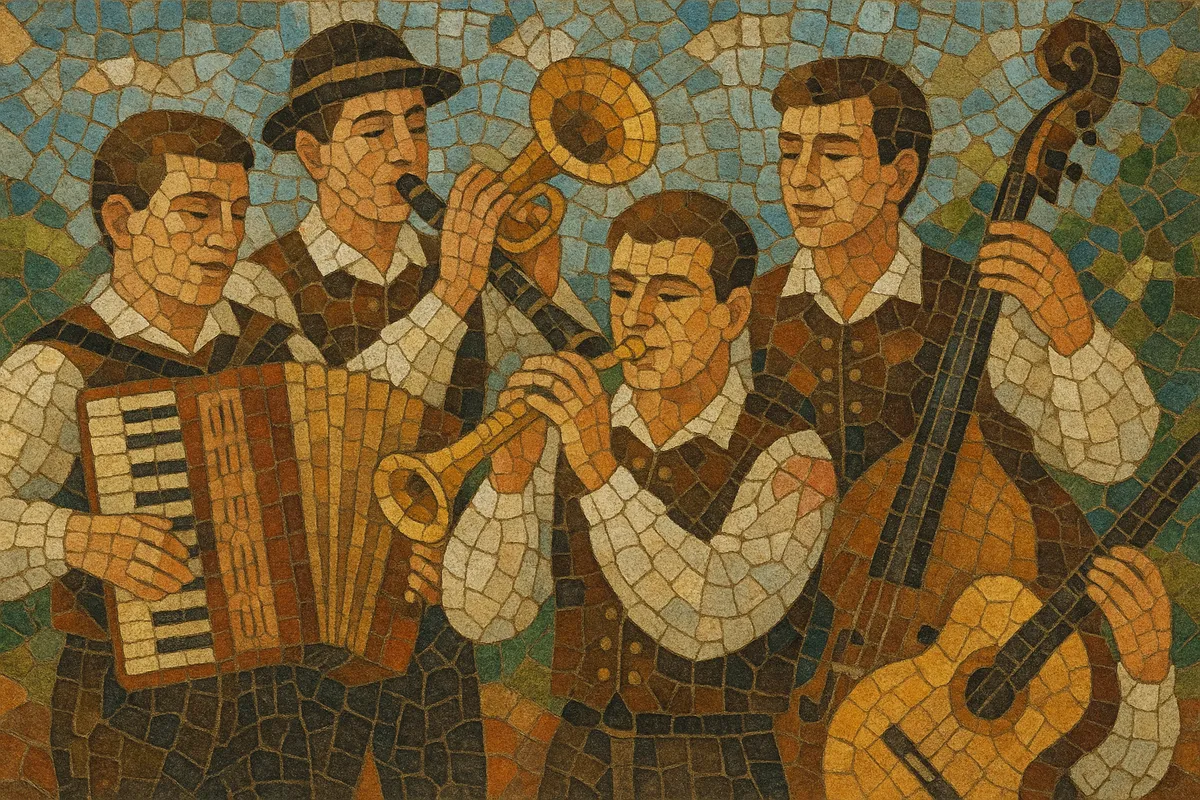Narodnozabavna glasba (often called the Oberkrainer style internationally) is a Slovenian popular-folk idiom built around lively polkas and graceful waltzes. It features a tight small-ensemble sound with accordion, clarinet, trumpet, guitar, and bass, plus close-harmony vocals.
The style is melodically catchy, rhythmically buoyant, and harmonically straightforward (I–IV–V with colorful secondary dominants). Lyrics commonly celebrate rural life, love, mountains, wine, and sociability, conveying an upbeat, communal spirit designed for dancing and sing-alongs.
Pioneered in the 1950s by the Avsenik Brothers Ensemble, the sound became a cross-border phenomenon in Central Europe, inspiring countless groups in Slovenia, Austria, Germany, and beyond, and shaping modern volkstümliche pop.
Narodnozabavna glasba emerged in Slovenia in the 1950s, crystallized by Ansambel bratov Avsenik (the Avsenik Brothers Ensemble). Drawing on local folk dance traditions—especially polka and waltz—Avsenik’s quintet format (accordion, clarinet, trumpet, guitar, bass) and distinctive arranging style defined the Oberkrainer sound. Their tight counterlines (clarinet vs. trumpet), buoyant rhythm section, and warm, close-harmony vocals set a new template for popular-folk music in the Alpine region.
Throughout the 1960s and 1970s, the style spread rapidly across Central Europe. Slovene artists toured extensively in German-speaking countries, where the music was marketed as “Oberkrainer.” Radio and television appearances, along with prolific record releases, helped standardize the idiom’s instrumentation, repertoire, and performance practice. In parallel, ensembles like Lojze Slak popularized the diatonic button accordion (frajtonarca), further rooting the music in Slovenian identity.
By the late 20th century, the genre had significantly shaped volkstümliche musik in Germany and Austria and intersected with schlager’s accessible songcraft. New ensembles modernized production while preserving the core dance rhythms (polka, waltz, schottische) and lyrical themes (homeland, nature, conviviality). Festivals, televised competitions, and dedicated radio formats sustained a vibrant scene.
Modern groups continue the tradition with fresh arrangements, occasional pop/rock touches, and polished studio sound. Intergenerational continuity—such as Saša Avsenik’s ensemble—keeps the repertoire alive, while younger bands balance authenticity with contemporary presentation for dances, weddings, and national celebrations.
Use the classic Oberkrainer quintet: accordion (piano or diatonic button), clarinet, trumpet, acoustic guitar (often lightly amplified), and double bass (or electric bass). Optional baritone/tenor horn can reinforce mid–low lines. Employ two- or three-part vocals (male lead with parallel thirds/sixths).
Center songs on polka (2/4, typically 120–135 BPM) and waltz (3/4, typically 85–105 BPM). For polka, aim for a firm “oom-pah” bass and crisp off-beat guitar. For waltz, emphasize a gentle downbeat with light sway on beats two and three. Include a schottische or march for set variety.
Write bright, singable melodies in major keys, using I–IV–V as a foundation with tasteful secondary dominants and brief modulations (often to V). Feature clarinet–trumpet countermelodies and short call-and-response with the accordion. Keep phrases tidy (4–8 bars) and conclude with memorable cadences.
Common forms: intro–verse–chorus–instrumental (accordion or clarinet/trumpet feature)–verse–chorus–coda. Use arranged interludes and modulations to lift repeats. Maintain clarity: melody up front, with tight rhythmic precision and light dynamic swells.
Write in Slovene (or neighboring languages for cross-border audiences). Themes should evoke rural life, mountains, love, friendship, and festivity. Keep tone warm and convivial; craft refrains that invite audience sing-alongs and dancing.


